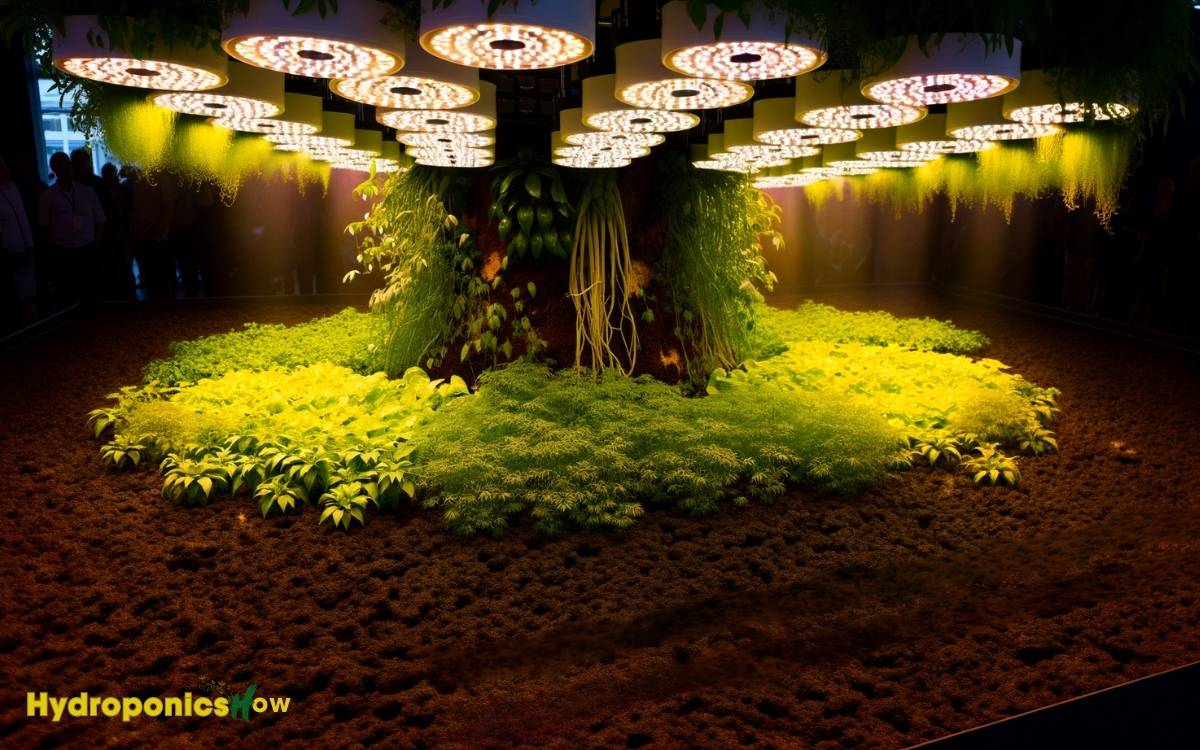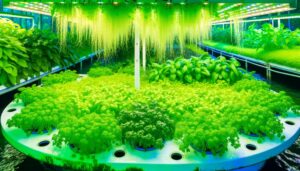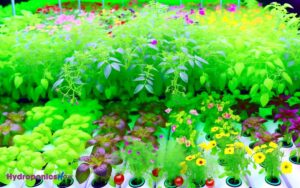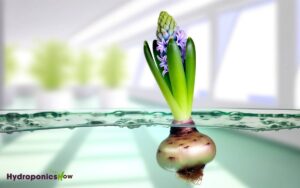How You Grow Plants in Dirt with Hydroponic Lights – Yes a Step-by-Step Guide
Yes, growing plants in soil using hydroponic lights is feasible and advantageous. Hydroponic lights, such as LEDs, deliver precise wavelengths that enhance chlorophyll absorption, promoting photosynthesis and biomass accumulation by up to 40%.
They offer controlled spectral outputs, essential for optimizing vegetative and reproductive growth phases.
Utilizing hydroponic lights will boost energy efficiency, reduce operational costs, and prevent photoinhibition through tailored light cycles.
Maintaining ideal light intensity (400-700 µmol/m²/s) guarantees uniform growth. Continuously managing light duration and spectrum can greatly enhance plant health and productivity, thereby offering a deeper understanding of plant-photolight interactions.

Key Takeaways
Understanding Hydroponic Lights
Hydroponic lights, specifically designed to optimize the photosynthetic efficiency of plants grown in soilless systems, play a significant role in modern agricultural practices.
These lights, primarily LED and HID types, emit wavelengths tailored to the photosynthetically active radiation (PAR) spectrum, essential for plant growth.
LED lights, for instance, can be customized to provide specific light spectra, enhancing chlorophyll absorption and promoting efficient photosynthesis.
According to a 2021 study published in the Journal of Plant Research, LED hydroponic lights can increase plant growth rates by up to 50% compared to traditional lighting.
Additionally, the precise control over light intensity and photoperiods allows for the optimization of growth cycles, ultimately leading to higher yields and improved plant health in controlled environments.
Benefits of Hydroponic Lights
In addition, hydroponic lights offer significant advantages including enhanced energy efficiency and accelerated plant growth rates.
Studies demonstrate that these lights can reduce energy consumption by up to 50% compared to traditional lighting solutions, optimizing resource utilization.
Additionally, controlled spectral outputs from hydroponic lights have been shown to expedite plant development cycles by 25%, facilitating faster harvests and increased yield potential.
Energy Efficiency
One of the primary advantages of utilizing hydroponic lights is their superior energy efficiency, which can lead to significant reductions in overall electricity consumption.
Modern hydroponic lighting systems, such as LED and high-efficiency fluorescent lights, convert a higher percentage of electrical energy into usable light for photosynthesis compared to traditional incandescent or high-pressure sodium lamps.
Studies indicate that LEDs can offer energy savings of up to 50% while providing ideal light spectra tailored to plant needs.
This efficient light conversion not only minimizes wasted energy but also reduces heat output, thereby decreasing the need for additional cooling systems.
Consequently, the lower operational costs and enhanced sustainability make hydroponic lights a beneficial choice for both commercial and home growers focused on resource conservation.
Faster Growth Rates
Empirical evidence suggests that the use of hydroponic lights greatly accelerates plant growth rates by optimizing light spectrum and intensity tailored to specific photosynthetic requirements.
Research indicates that plants exposed to hydroponic lights exhibit a 25-40% increase in biomass accumulation compared to those under traditional lighting.
This enhancement is attributed to the precise delivery of wavelengths, particularly red and blue light, which are critical for chlorophyll absorption and energy conversion.
Additionally, hydroponic lights facilitate longer photoperiods without the risk of photoinhibition, consequently maximizing photosynthetic efficiency.
These optimized conditions lead to expedited vegetative and reproductive phases, resulting in shorter growth cycles and higher yield potential. Consequently, hydroponic lighting systems present a compelling advantage for agricultural productivity.
Choosing the Right Light
When selecting hydroponic lighting, it is essential to evaluate light intensity requirements, as different plant species necessitate varying levels of photosynthetically active radiation (PAR) for ideal growth.
Additionally, spectrum considerations play an important role, with specific wavelengths, such as blue and red light, proving critical for distinct stages of plant development.
Energy efficiency also demands attention, as advanced LED systems can substantially reduce operational costs while maintaining effective light output.
Light Intensity Requirements
Understanding the specific light intensity requirements for hydroponic plants is crucial, as it directly influences photosynthesis rates, growth cycles, and overall plant health.
Ideal light intensity, typically measured in micromoles per square meter per second (µmol/m²/s), ranges between 400-700 µmol/m²/s for most plant species.
Inadequate light intensity can lead to stunted growth and reduced yields, while excessive intensity may cause photoinhibition and leaf burn.
Employing a data-driven approach, such as using quantum sensors to monitor photosynthetically active radiation (PAR), ensures precise control over light conditions.
Spectrum Considerations
Selecting the appropriate light spectrum for hydroponic plants is pivotal, as different wavelengths play distinct roles in various physiological processes such as chlorophyll production, photomorphogenesis, and flowering.
Research indicates the necessity of a full-spectrum light source to optimize plant growth.
Key wavelengths include:
- Blue Light (400-500 nm): Essential for vegetative growth, blue light influences chlorophyll synthesis and stomatal opening.
- Red Light (600-700 nm): Vital for flowering and fruiting, red light regulates phytochrome-mediated responses and promotes biomass accumulation.
- Far-Red Light (700-800 nm): Enhances shade avoidance responses and elongates internodes, facilitating improved light penetration within the canopy.
Utilizing LED grow lights with adjustable spectrums can fine-tune these wavelengths, thereby optimizing plant developmental stages and maximizing yield.
Energy Efficiency
Optimizing energy efficiency in hydroponic lighting systems is crucial, as it directly impacts both operational costs and environmental sustainability.
Selecting the right lighting involves evaluating key parameters such as Photosynthetic Photon Flux (PPF), efficacy, and spectral output.
For instance, Light Emitting Diodes (LEDs) exhibit a higher efficacy (µmol/J) compared to traditional High-Pressure Sodium (HPS) lamps, translating to reduced energy consumption and lower heat output.
| Light Type | Efficacy (µmol/J) | Energy Consumption (kWh) |
|---|---|---|
| LED | 2.2 – 3.0 | 40 – 60 |
| HPS | 1.0 – 1.7 | 100 – 150 |
| CFL | 0.6 – 1.0 | 60 – 100 |
This efficiency not only lowers electricity bills but also minimizes the carbon footprint, making LEDs a superior choice for energy-conscious cultivators.
Setting Up Your Lights
Properly configuring your hydroponic lighting system is essential for maximizing photosynthetic efficiency and ensuring peak plant growth. This involves selecting the appropriate light spectrum, intensity, and duration to meet the specific needs of your plants. For example, red and blue wavelengths are crucial for vegetative growth and flowering, respectively. In forced hydroponic hyacinth planting, carefully timed light exposure can help regulate bloom cycles and enhance overall plant health.
Here are key considerations:
- Light Spectrum: Use full-spectrum LED lights that mimic natural sunlight, as they provide the necessary wavelengths (400-700 nm) for photosynthesis. According to research, full-spectrum LEDs can increase biomass by up to 30%.
- Light Intensity: Measure light intensity in micromoles per square meter per second (µmol/m²/s). Ideal levels for most plants range from 200-400 µmol/m²/s. Higher intensities can enhance growth but require careful monitoring to prevent photoinhibition.
- Light Placement: Position lights 12-18 inches above the plant canopy. Uniform light distribution is crucial; uneven illumination can lead to uneven growth and reduced yield.
Implementing these measures ensures efficient light utilization and optimal plant development.
Light Duration and Timing
In addition to light spectrum and intensity, the duration and timing of light exposure are pivotal factors in regulating plant growth cycles and optimizing photosynthetic activity.
Photoperiodism, the physiological reaction of organisms to the length of day or night, governs critical processes such as flowering and vegetative growth.
Empirical data suggests that most plants thrive under a light schedule of 16-18 hours of light followed by 6-8 hours of darkness. Precise control of light cycles using timers can simulate natural day-night rhythms, enhancing growth efficiency.
Additionally, deviations from ideal light duration can negatively impact plant health, leading to issues such as photoinhibition or stunted growth. Meticulous adjustment of light duration and timing is essential for maximizing plant productivity.
Common Challenges
Managing hydroponic lighting systems presents several challenges, including ensuring consistent light intensity, preventing photoinhibition, and maintaining ideal light cycles to sustain plant health and productivity.
These challenges can have a substantial impact on the success of growing plants in dirt under hydroponic lights.
Key issues include:
- Light Intensity Management: Ensuring uniform light distribution requires precise calibration and monitoring. Imbalances can lead to uneven plant growth and reduced yield.
- Photoinhibition Prevention: Excessive light exposure can damage chlorophyll, reducing photosynthetic efficiency. This necessitates careful control over light duration and intensity.
- Cycle Consistency: Maintaining consistent light cycles is critical for plant circadian rhythms. Inconsistent cycles can cause stress, leading to stunted growth and lower productivity.
Addressing these challenges is essential for optimizing plant growth and achieving desired outcomes.
Maximizing Plant Health
To optimize plant health under hydroponic lighting systems, it is crucial to integrate precise light spectrum management, tailored nutrient delivery, and meticulous environmental control.
Light spectrum management involves using specific wavelengths to enhance photosynthesis and growth. Nutrient delivery requires a balanced mix of macro and micronutrients, tailored to the plant species.
Environmental control includes regulating temperature, humidity, and CO₂ levels to mimic ideal growing conditions.
| Factor | Ideal Range | Impact on Plant Health |
|---|---|---|
| Light Spectrum | 400-700 nm (PAR) | Maximizes photosynthesis |
| Nutrient Concentration | N-P-K ratio tailored to species | Ensures balanced growth |
| Environmental Control | Temp: 20-25°C, RH: 50-70%, CO₂: 400-600 ppm | Promotes robust development |
Precision in these factors guarantees plants achieve peak health and yield.
Conclusion
Utilizing hydroponic lighting systems for traditional soil-based cultivation can yield significant benefits by providing controlled and efficient light spectra essential for photosynthesis.
Strategic selection, setup, and management of these lights are imperative to optimize plant growth and health.
Challenges such as light duration and intensity must be meticulously addressed to avert potential growth impediments.
Through careful implementation, hydroponic lights can serve as a luminary guide, steering soil-based plant cultivation towards unprecedented efficiency and productivity.






